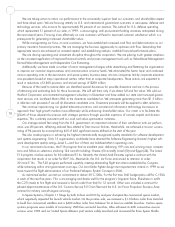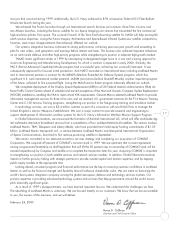Lockheed Martin 1999 Annual Report Download - page 16
Download and view the complete annual report
Please find page 16 of the 1999 Lockheed Martin annual report below. You can navigate through the pages in the report by either clicking on the pages listed below, or by using the keyword search tool below to find specific information within the annual report.
23
Lockheed Martin Corporation
COMSAT upon consummation of the Merger. Given the
substantial investment necessary for the growth of the
global telecommunications services business, support from
strategic partners for Global Telecommunications may be
sought and public equity markets may be accessed to raise
capital, although the Corporation cannot predict the out-
come of these efforts.
Divestiture Activities
In March 1997, the Corporation repositioned 10 of its
non-core business units as a new independent company,
L-3 Communications Holdings, Inc. (L-3), in which the
Corporation retained an approximate 35 percent owner-
ship interest at closing. The Corporation’s ownership per-
centage was reduced to approximately 25 percent in the
second quarter of 1998 as a result of an initial public
offering of L-3’s common stock. In 1999, the Corporation
sold its remaining shares of L-3 in two separate transac-
tions. On a combined basis, these transactions increased
1999 pretax earnings by $155 million, and increased net
earnings by $101 million, or $.26 per diluted share.
In September 1999, the Corporation sold its interest
in Airport Group International Holdings, LLC which resulted
in a pretax gain of $33 million. In October 1999, the
Corporation exited its commercial 3D graphics business
through a series of transactions which resulted in the sale of
its interest in Real 3D, Inc., a majority-owned subsidiary,
and a pretax gain of $33 million. On a combined basis,
these transactions increased net earnings by $43 million, or
$.11 per diluted share.
In November 1997, Lockheed Martin exchanged all of
the outstanding capital stock of a wholly-owned subsidiary
for all of the outstanding Series A preferred stock held by
General Electric Company (GE) and certain subsidiaries
of GE (the GE Transaction). The Series A preferred stock
was convertible into approximately 58 million shares of
Lockheed Martin common stock. The Lockheed Martin
subsidiary was composed of two non-core commercial
business units which contributed approximately five percent
of the Corporation’s 1997 net sales, Lockheed Martin’s
investment in a telecommunications partnership and approx-
imately $1.6 billion in cash. The GE Transaction was
accounted for at fair value, and resulted in the reduction
of the Corporation’s stockholders’ equity by $2.8 billion
and the recognition of a tax-free gain of approximately
$311 million in other income and expenses. Also see the
discussion under the caption “Results of Operations”
regarding the impact of the GE Transaction on the com-
putation of 1997 earnings per share. In 1998 and 1997,
in connection with the GE Transaction, the Corporation
issued notes to a wholly-owned subsidiary of GE for
$210 million, bearing interest at 5.73%, and $1.4 billion,
bearing interest at 6.04%, respectively. The notes are
due November 17, 2002.
Industry Considerations
The Corporation’s primary lines of business are in
advanced technology systems, products and services for
aerospace and defense, serving both government and
commercial customers. In recent years, domestic and world-
wide political and economic developments have strongly
affected these markets, requiring significant adaptation by
market participants.
The U.S. aerospace and defense industry has experi-
enced years of declining budgets for research, development,
test and evaluation, and procurement. After over a decade
of continuous declines in the U.S. defense budget, the por-
tion of the Federal budget devoted to defense is at one of
its lowest levels in modern history. In addition, worldwide
defense budgets have been declining with a focus on
operational readiness and personnel issues at the expense
of acquisition programs, with modernization becoming
increasingly popular over acquisition. Consequently, an
increasing portion of expenditures for defense is used for
upgrading and modernizing existing equipment rather
than acquisition of new equipment. Such trends in defense
spending have created risks associated with demand and
timing of orders relative to certain of the Corporation’s
existing programs. For example, the Corporation has not
received the level of orders anticipated for the C-130J airlift
aircraft program which has resulted in lower than expected
production levels. The Corporation is continuing to focus its
efforts on new orders from foreign and domestic customers,
though it cannot predict the outcome of these efforts.
























